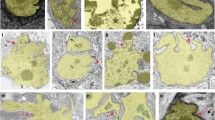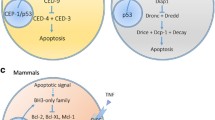Abstract
Cell death in animals is normally classified as type I (apoptotic), type II (autophagic) or necrotic. Of the biologically controlled types of death, in most embryos apoptosis is the most common, although in metamorphosis and in cells with massive cytoplasm type II is often seen, and intermediate forms are seen. For vertebrate embryos other than mammals, apoptosis is not seen prior to gastrulation but thereafter is used to sculpt the organs of the embryo, while overproduction of cells with subsequent death of excess cells is a common means of generating high specificity with low information cost. In zebrafish at least, the inability of embryos prior to the maternal-zygotic transition to undergo apoptosis appears to derive from the inability of the cells to resist lysis once apoptosis begins, rather than any inhibition of apoptosis. In mammalian embryos, apoptosis is seen during cavitation. Thereafter, as in other embryos, cell death plays a major role in shaping and sculpting the embryo. In those situations that have been carefully studied, cell death is under tight genetic control (including regulation of gene products whose function in cell death is not yet known, such as cdk5), with activation of apoptosis sometimes regulated by local environmental variables.




Similar content being viewed by others
References
Abdelwahid E, Pelliniemi LJ, Jokinen E (2002) Cell death and differentiation in the development of the endocardial cushion of the embryonic heart. Microsc Res Tech 58(5):395–403
Abrams JM, White K, Fessler LI, Steller H (1993) Programmed cell death during Drosophila embryogenesis. Development 117:29–43
Avallone B, Balsamo G, Trapani S, Marmo F (2002) Apoptosis during chick inner ear development: some observations by TEM and TUNEL techniques. Eur J Histochem 46(1):53–59
Ballard KJ, Holt SJ (1968) Cytological and cytochemical studies on cell death and digestion in the foetal rat foot: the role of macrophages and hydrolytic enzymes. J Cell Sci 3:245–262
Barres BA, Raff MC (1999) Axonal control of oligodendrocyte development. J Cell Biol 147:1123–1128
Bortner CD, Cidlowski JA (2002) Apoptotic volume decrease and the incredible shrinking cell. Cell Death Differ 9:1307–1310
Chanoine C, Hardy S (2003) Xenopus muscle development: from primary to secondary myogenesis. Dev Dyn 226(1):12–23
Chen P, Nordstrom W, Gish B, Abrams JM (1996) Grim, a novel cell death gene in Drosophila. Genes Dev 10(14):1773–1782
Coen L, du Pasquier D, Le Mevel S, Brown S, Tata J, Mazabraud A (2001) Xenopus Bcl-X(L) selectively protects Rohon-Beard neurons from metamorphic degeneration. Proc Natl Acad Sci USA 98:7869–7874
Cole LK, Ross LS (2001) Apoptosis in the developing zebrafish embryo. Dev Biol 240:123–142
Coucouvanis ED, Martin GR, Nadeau JH (1995) Genetic approaches for studying programmed cell death during development of the laboratory mouse. Methods Cell Biol 46:387–440
Dhavan R, Tsai LH (2001) A decade of CDK5. Nat Rev Mol Cell Biol 2(10):749–759
Edinger AL, Thompson CB (2004) Death by design: apoptosis, necrosis and autophagy. Curr Opin Cell Biol 16(6):663–669
Fahrbach SE, Choi MK, Truman JW (1994) Inhibitory effects of actinomycin D and cycloheximide on neuronal death in adult Manduca sexta. J Neurobiol 25(1):59–69
Fox H (1973) Ultrastructure of tail degeneration in Rana temporaria larvae. Folia Morphol (Prague) 21:109–112
Fukuda H (2000) Programmed cell death of tracheary elements as a paradigm in plants. Plant Mol Biol 44(3):245–253
Gao CY, Zakeri Z, Zhu Y, He H, Zelenka PS (1997) Expression of Cdk5, p35, and Cdk5 associated kinase activity in the developing rat lens. Dev Genet 20:267–275
Gercel-Taylor C, O’Connor SM, Lam GK, Taylor DD (2002) Shed membrane fragment modulation of CD3-zeta during pregnancy: link with induction of apoptosis. J Reprod Immunol 56(1–2):29–44
Glücksmann A (1951) Cell deaths in normal vertebrate ontogeny. Biol Rev Camb Philos Soc 26:59–86
Gordon N (1995) Apoptosis (programmed cell death) and other reasons for elimination of neurons and axons. Brain Dev 17:73–77
Grether ME, Abrams JM, Agapite J, White K, Steller H (1995) The head involution defective gene of Drosophila melanogaster functions in programmed cell death. Genes Dev 9(14):1694–1708
Gupta A, Tsai LH, Wynshaw-Boris A (2002) Life is a journey: a genetic look at neocortical development. Nat Rev Genet 3(5):342–355
Haas AL, Baboshina O, Williams B, Schwartz LM (1995) Coordinated induction of the ubiquitin conjugation pathway accompanies the developmentally programmed death of insect skeletal muscle. J Biol Chem 270(16):9407–9412
Hardy K, Handyside AH, Winston RM (1989) The human blastocyst: cell number, death and allocation during late preimplantation development in vitro. Development 107:597–604
Haslett C, Savill JS, Whyte MKB, Stern M, Dransfield I, Meagher LC (1994) Granulocyte apoptosis and the control of inflammation. Philos Trans R Soc Lond B Biol Sci 345:327–333
Hoeberichts FA, Woltering EJ (2003) Multiple mediators of plant programmed cell death: interplay of conserved cell death mechanisms and plant-specific regulators. Bioessays 25(1):47–57
Horvitz HR, Shaham S, Hengartner MO (1994) The genetics of programmed cell death in the nematode Caenorhabditis elegans. Cold Spring Harb Symp Quant Biol 59:377–386
Hurle JM, Colombatti A (1996) Extracellular matrix modifications in the interdigital spaces of the chick embryo leg bud during the formation of ectopic digits. Anat Embryol (Berl) 193(4):355–364
Jeffery WR (2002) Programmed cell death in the ascidian embryo: modulation by FoxA5 and Manx and roles in the evolution of larval development. Mech Dev 118(1–2):111–124
Jochová J, Quaglino D, Zakeri Z, Woo K, Sikorska M, Weaver V, Lockshin RA (1997a) Protein synthesis, DNA degradation, and morphological changes during programmed cell death in labial glands of Manduca sexta. Dev Genet 21:249–257
Jochová J, Zakeri Z, Lockshin RA (1997b) Rearrangement of the tubulin and actin cytoskeleton during programmed cell death in Drosophila salivary glands. Cell Death Differ 4:140–149
Kuriyama H, Fukada H (2002) Developmental programmed cell death in plants. Curr Opin Plant Biol 5(6):568–573
Ledda-Columbano GM, Coni P, Curto M, Giacomini L, Faa G, Oliverio S, Piacentini M, Columbano A (1991) Induction of two different modes of cell death, apoptosis and necrosis, in rat liver after a single dose of thioacetamide. Am J Pathol 139:1099–1109
Lee CY, Cooksey BA, Baehrecke EH (2002) Steroid regulation of midgut cell death during Drosophila development. Dev Biol 250(1):101–111
Lin L, Ye YX, Zakeri Z (2006) p53, Apaf-1, caspase-3, and -9 are dispensable for Cdk5 activation during cell death. Cell Death Differ 13(1):141–150
Lockshin RA, Beaulaton J (1981) Cell death: questions for histochemists concerning the causes of the various cytological changes. Histochem J 13:659–666
Lockshin RA, Facey CO, Zakeri Z (2001) Cell death in the heart. Cardiol Clin 19:1–11
Mohamed YH, Amemiya T (2003) Apoptosis and lens vesicle development. Eur J Ophthalmol 13(1):1–10
Negron JF, Lockshin RA (2004) Activation of apoptosis and caspase-3 in zebrafish early gastrulae. Dev Dyn 231:161–170
Osborne BA (1998) Apoptotic signaling in lymphocytes. In: Lockshin RA, Zakeri Z, Tilly JL (eds) When cells die: a comprehensive evaluation of apoptosis and programmed cell death. Wiley-Liss, New York, pp 245–266
Reynaud K, Driancourt MA (2000) Oocyte attrition. Mol Cell Endocrinol 163:101–108
Schmied M, Breitschopf H, Gold R, Zischler H, Rothe G, Wekerle H, Lassmann H (1993) Apoptosis of T lymphocytes in experimental autoimmune encephalomyelitis: evidence for programmed cell death as a mechanism to control inflammation in the brain. Am J Pathol 143:446–452
Schwartz LM, Myer A, Kosz L, Engelstein M, Maier C (1990) Activation of polyubiquitin gene expression during developmentally programmed cell death. Neuron 5:411–419
Solomon M, Belenghi B, Delledonne M, Menachem E, Levine A (1999) The involvement of cysteine proteases and protease inhibitor genes in the regulation of programmed cell death in plants. Plant Cell 11(3):431–444
Spanos S, Rice S, Karagiannis P, Taylor D, Becker DL, Winston RM, Hardy K (2002) Caspase activity and expression of cell death genes during development of human preimplantation embryos. Reproduction 124(3):353–63
Steller H, Grether ME (1994) Programmed cell death in Drosophila. Neuron 13:1269–1274
Svoboda KR, Linares AE, Ribera AB (2001) Activity regulates programmed cell death of zebrafish Rohon-Beard neurons. Development 128:3511–3520
de Torres C, Munell F, Roig M, Reventos J, Macaya A (2002) Naturally occurring cell death during postnatal development of rat skeletal muscle. Muscle Nerve 26(6):777–783
Vyas S, Bechade C, Riveau B, Downward J, Triller A (2002) Involvement of survival motor neuron (SMN) protein in cell death. Hum Mol Genet 11(22):2751–2764
White K, Grether ME, Abrams JM, Young L, Farrell K, Steller H (1994) Genetic control of programmed cell death in Drosophila. Science 264:677–683
Williams JA, Barrios A, Gatchalian C, Rubin L, Wilson SW, Holder N (2000) Programmed cell death in zebrafish rohon beard neurons is influenced by TrkC1/NT-3 signaling. Dev Biol 226:220–230
Wu GS, Ding Z (2002) Caspase 9 is required for p53-dependent apoptosis and chemosensitivity in a human ovarian cancer cell line. Oncogene 21(1):1–8
Xue L, Fletcher GC, Tolkovsky AM (1999) Autophagy is activated by apoptotic signalling in sympathetic neurons: an alternative mechanism of death execution. Mol Cell Neurosci 14:180–198
Xue L, Fletcher GC, Tolkovsky AM (2001) Mitochondria are selectively eliminated from eukaryotic cells after blockade of caspases during apoptosis. Curr Biol 11:361–365
Yüce Ó, Sadler KC (2001) Post-meiotic unfertilized starfish eggs die by apoptosis. Dev Biol 237:29–44
Zakeri Z, Ahuja HS (1994) Apoptotic cell death in the limb and its relationship to pattern formation. Biochem Cell Biol 72:603–613
Zakeri Z, Lockshin RA (2002) Cell death during development. J Immunol Methods 265(1–2):3–20
Zakeri Z, Quaglino D, Ahuja HS (1994) Apoptotic cell death in mouse limb and its suppression in the hammertoe mutant. Dev Biol 165:294–297
Zakeri Z, Lockshin RA, Criado-Rodriguez LM, Martinez-A C (2005) A generalized caspase inhibitor disrupts early mammalian development. Int J Dev Biol 49(1):43–47
Zhang Q, Ahuja HS, Zakeri Z, Wolgemuth DJ (1997) Cyclin-dependent kinase 5 is associated with apoptotic cell death during developmental and tissue remodeling. Dev Biol 183:222–233
Zhu Y, Lin L, Kim S, Quaglino D, Lockshin RA, Zakeri Z (2002) Cyclin dependent kinase 5 and its interacting proteins in cell death induced in vivo by cyclophosphamide in developing mouse embryos. Cell Death Differ 9(4):421–430
Acknowledgements
The authors wish to thank Drs. Yong Zhu and Daniela Quaglino for their technical assistance. We would also like to thank NYC-LSAMP and MAGNET-AGEP, sponsored by NSF and the National Institutes of Health (MARC Minority Access to Research Careers) GM 070387-01 for their support.
Author information
Authors and Affiliations
Corresponding author
Rights and permissions
About this article
Cite this article
Penaloza, C., Lin, L., Lockshin, R.A. et al. Cell death in development: shaping the embryo. Histochem Cell Biol 126, 149–158 (2006). https://doi.org/10.1007/s00418-006-0214-1
Accepted:
Published:
Issue Date:
DOI: https://doi.org/10.1007/s00418-006-0214-1




